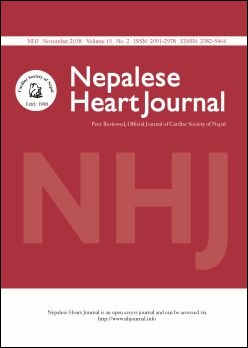Evaluating QT dispersion in children with syncope attacks
DOI:
https://doi.org/10.3126/njh.v15i2.21471Keywords:
QT interval, QTd dispersion, QTcd dispersion, Syncope.Abstract
Background and Aims: Syncope is due to brain dysfunction and is a common compliant among children. It accounts for almost 3% of all emergency departments (ED) visits. The aim of this study was to evaluate the QT dispersion in children with syncope in Shahid Beheshti Hospital of Kashan in 2014.
Methods: This was a descriptive cross-sectional study performed among 50 children with syncope attacks (case group) referred to the Clinic of Shahid Beheshti Hospital in Kashan during 2014 and 50 healthy children (control group) referred to the center for causes such as a cold or developmental examination. ECG was taken and QT, QTd (QT dispersion), QTc (Corrected QT interval) and QTcd (QTmin-QTmax =QT dispersion) intervals were studied. After proper explanation to the parents, data was obtained from the case and control group and was analyzed using Chisquare, Mann-Whitney, Kolmogorov–Smirnov, Levene›s, Kruskal-Wallis statistical tests.
Results: Total, there were 100 children in the study, the participants were divided into two groups of case (n=50) and control (n=50). Among the studied children, a total of 46 of them (46%) were boys. The mean age range of children in the case and control groups were 7.73± 2.33 and 8.09± 2.31 years, respectively (P-value 0.440). The mean QTmax, QTcmax, QTd and QTcd in the case group were 348.80 ± 46.93, 464.94±48.71, 47.80±19.72, 68.36±24.59 ms (millisecond) respectively and 305.28 ±35.52, 395.70 ±50.05, 29.68±13.45, and 45.16±24.46 ms respectively in the control group. There was a significant difference in terms of each of the 4 parameters (P <0.001), and the value of indices in the control group was significantly less than that of the patient group.
Conclusion: According to the results of the study, the QTd and QTcd values in the children with syncope attacks were higher than those in the control group. Therefore, precise ECG examination in children suspected of syncope attacks can be helpful in confirming the incidence of syncope. Additionally, the recurrence of attacks can also be predicted in children with higher QTd and QTcd values.
Downloads
Downloads
Published
How to Cite
Issue
Section
License
This license enables reusers to distribute, remix, adapt, and build upon the material in any medium or format, so long as attribution is given to the creator. The license allows for commercial use.




